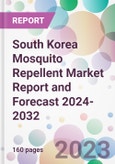Mosquito repellents consist of substances or devices designed to repel mosquitoes, thus preventing bites and the potential transmission of diseases. They come in various forms, including sprays, creams, coils, and electronic devices. Mosquito repellents play a crucial role in public health by preventing the spread of diseases such as dengue fever, malaria, and zika virus.
The increasing awareness about mosquito-borne diseases is a primary driver of the South Korea mosquito repellent market growth. With the rise in cases of dengue fever, malaria, and other mosquito-borne diseases in recent years, there has been a surge in demand for mosquito repellents. Public health campaigns that educate people about the importance of mosquito control measures have further fuelled this demand.
The rising use of insect repellents in numerous industries has also made a significant contribution to the South Korea mosquito repellent market expansion. During the mosquito breeding season, which often corresponds with the rainy season, there is an increase in demand for mosquito repellents in the residential sector. While in the commercial sector, establishments like hotels, resorts, and restaurants use insect repellents to give their patrons a comfortable space.
Additionally, the development and introduction of novel items is propelling the market growth. The development of repellents that are secure, efficient, and simple to use has been a priority for producers. Consumer interest in mosquito repellents has significantly expanded as a result of innovations like wearable repellents, clothing with repellent in it, and electronic repellent gadgets.
The South Korea mosquito repellent market has grown dramatically because of the expanding online retail sector. Consumers now have simple access to a variety of products due to the growth of e-commerce platforms. They can quickly compare costs, read reviews, and make purchases from the comfort of their homes, expanding the market for mosquito repellents.
Market Segmentation
The market can be divided based on after-bite type, repellent type, and distribution channel.Market Breakup by After-Bite Type
- Lotion
- Balm
- Gels
- Roll- On
- Others
Market Breakup by Repellent Type
- Spray
- Vaporiser
- Mat
- Coil
- Cream and Oil
- Others
Market Breakup by Distribution Channel
- Supermarkets and Hypermarkets
- Independent Stores
- Online
- Others
Competitive Landscape
The report looks into the market shares, plant turnarounds, capacities, investments, and mergers and acquisitions, among other major developments, of the leading companies operating in the South Korea mosquito repellent market. Some of the major players explored in the report are as follows:- Henkel AG & Co. KGaA
- DBK Korea Co., Ltd.
- Reckitt Benckiser Group PLC.
- SC Johnson & Son, Inc.
- Others
Table of Contents
Companies Mentioned
- Henkel AG & Co. KGaA
- DBK Korea Co. Ltd.
- Reckitt Benckiser Group PLC.
- SC Johnson & Son Inc.
Methodology

LOADING...








